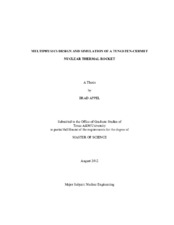| dc.description.abstract | The goal of this research is to apply modern methods of analysis to the design of a tungsten-cermet Nuclear Thermal Rocket (NTR) core. An NTR is one of the most viable propulsion options for enabling piloted deep-space exploration. Concerns over fuel safety have sparked interest in an NTR core based on tungsten-cermet fuel. This work investigates the capability of modern CFD and neutronics codes to design a cermet NTR, and makes specific recommendations for the configuration of channels in the core.
First, the best CFD practices available from the commercial package Star-CCM+ are determined by comparing different modeling options with a hot-hydrogen flow experiment. Next, through grid convergence and sensitivity studies, numerical uncertainty is shown to be a small contributor to overall uncertainty; while fuel thermal conductivity, hydrogen specific heat, and fission energy deposition are found to have a large impact on simulation uncertainty. The model-form error is then estimated by simulation of a NERVA fuel element from an NRX-A6 engine test, where the peak temperature matches measured data to within 2.2%. Using a combination of Star-CCM+ and MCNP for neutronics, typical uncertainties are estimated at 3% for predicting fuel temperature, 2% for hydrogen temperature, and 5% for pressure.
The second part uses the aforementioned analysis methods in a parametric study to determine what coolant channel size and distribution is optimum for a 10 klbf-thrust cermet NTR core. By varying the channel diameter and pitch-to-diameter ratio (p/d), it is found that a diameter of 0.12 cm with a p/d of 1.8 results in the lightest core with a peak temperature of 2850 K. The study also shows that element-by-element mass flow rate zoning is the best method for handling radial power peaking. In addition, a detailed simulation of a cermet design developed at the Argonne National Laboratory shows that modifications to the historical fuel element design are required to avoid overheating.
The final part investigates the ability of Star-CCM+ to model fuel element failure modes. Through a combination of uncertainty quantification and a parametric analysis, this thesis ultimately lays a groundwork for future detailed design of cermet NTR fuel elements. | en |


